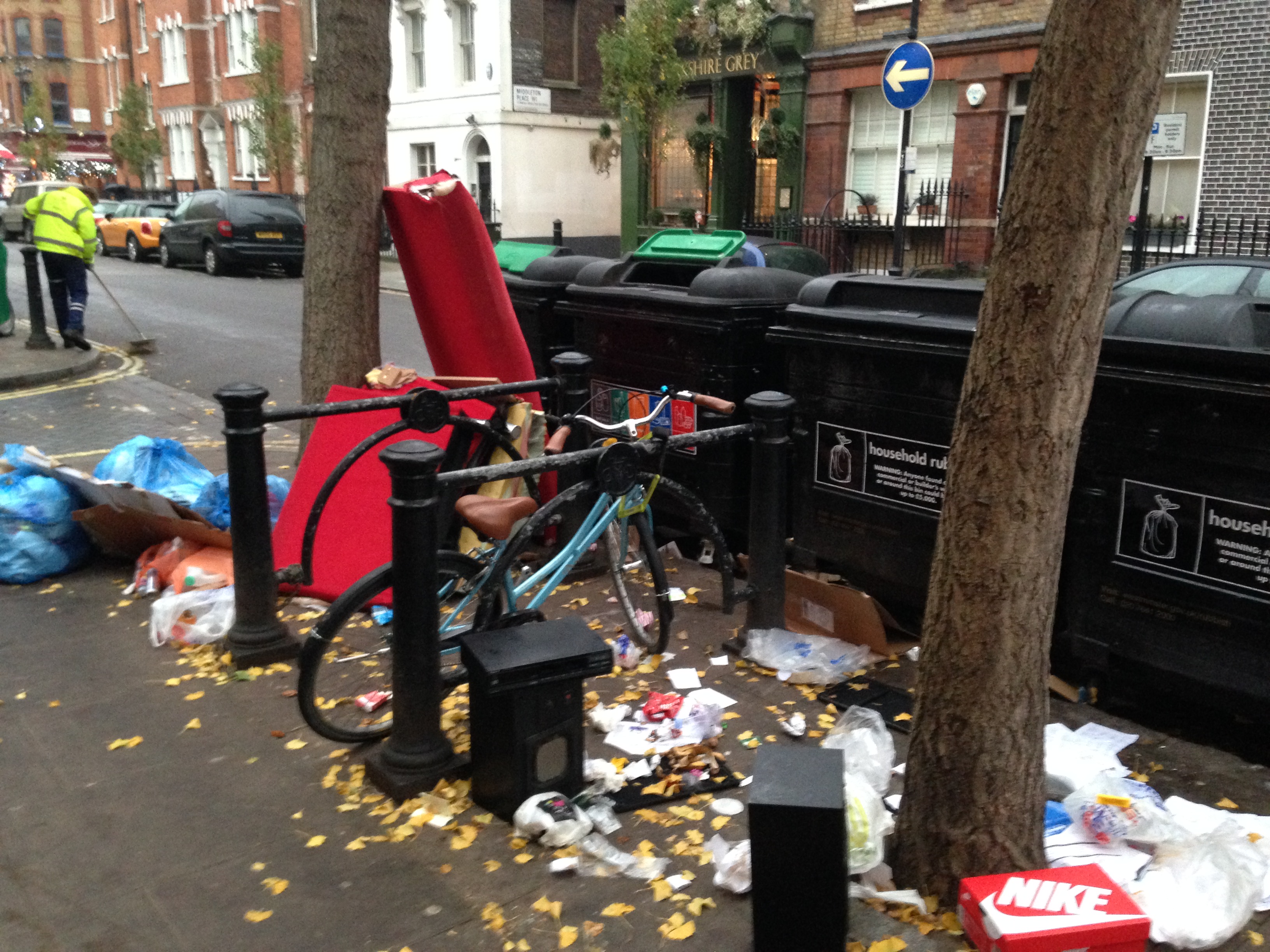
by Julia Haythorn | Nov 27, 2015 | Info
This Neighbourhood Executive has been concerned for some time that all the processes regarding the charging of Community Infrastructure Levy (CIL) have gone ahead without any consultation with the neighbourhood forums. This is curious because the Localism Bill expressly states that properly constituted neighbourhood forums should be fully consulted and their priorities be used to account for spending of 15% now and 25% of the CIL once the Neighbourhood Plan is agreed by referendum.
Communities without a Parish, Town or Community Council will still benefit from the 15% neighbourhood portion (or 25% portion, if a neighbourhood plan or neighbourhood development order has been made). If there is no Parish, Town or Community Council, the charging authority will retain the levy receipts but should engage with the communities where development has taken place and agree with them how best to spend the neighbourhood funding. Charging authorities should set out clearly and transparently their approach to engaging with neighbourhoods using their regular communication tools e.g. website, newsletters, etc. The use of neighbourhood funds should therefore match priorities expressed by local communities, including priorities set out formally in neighbourhood plans.
The Government does not prescribe a specific process for agreeing how the neighbourhood portion should be spent. Charging authorities should use existing community consultation and engagement processes. This should include working with any designated neighbourhood forums preparing neighbourhood plans that exist in the area, theme specific neighbourhood groups, local businesses (particularly those working on business led neighbourhood plans), and using networks that ward councillors use. Crucially this consultation should be at the neighbourhood level. It should be proportionate to the level of levy receipts and the scale of the proposed development to which the neighbourhood funding relates.
http://planningguidance.communities.gov.uk/blog/guidance/community-infrastructure-levy/spending-the-levy/
We are pleased to have received the enclosed letter from Councillor Robert Davis today, clarifying their understanding of the issue. We welcome the fact Westminster City Council are aware of the duty to consult fully with the Neighbourhood Forums on the expenditure of the neighbourhood proportion of CIL. We look forward to fruitful discussions. Perhaps now some of the local issues like rubbish collection and the state of the streets can be properly addressed.
151127 CIL Neighbourhood letter November 2015
Here is our response:
Dear Councillor Davis,
CIL
Thank you for your letter received today, we have placed a copy of the letter on our website with this reply.
We were aware of the procedures advised by government and thus slightly curious as to why the Neighbourhood Forums were not consulted at the time the council reviewed infrastructure expenditure.
However, we accept that you will now be undertaking a wider consultation process to come to agreement with the new neighbourhood forums as to how that proportion of CIL should be expended.
We assume that you will be contacting us again soon so that a process and programme of discussion can be devised that will lead to a final agreement with the various neighbourhood forums.
I have put forward the suggestion that the West End Neighbourhood Forums have many priorities in common, and that it would be prudent to work together as a group. We await officers response to that proposal.
In addition I note that government advice supports the involvement of Ward Councillors. Our Ward Councillors have not yet attended any of our executive meetings, but some of them have been present at our public consultations. We urge any of them that are not yet formal members of the forum to join, so that they automatically receive information about issues of importance to the community.
We are holding another exhibition on Monday 11th January 2016, at the Getty Gallery Eastcastle Street from 11.00am to 8.00pm, where our draft policies and priorities will be made public. We do hope that your officers and politicians will want to attend. In particular we are holding a briefing in the evening and hope that as many as possible can come.
We are looking forward to a positive and productive dialogue, and look forward to hearing more from your CIL team in the not too distant future.
With best wishes
Wendy Shillam
27 November 2015
The response is:
Dear Wendy,
Thank you for your email of 27th November. My apologies for not responding to you sooner, but all of our efforts in this area have been focussed on the recent Westminster Community Infrastructure Levy (CIL) public examination and the work arising from.
I am very grateful for your views on the importance of a positive and productive dialogue about the best and most effective way of involving neighbourhoods in agreeing how the neighbourhood CIL funding proportion will be spent. My team will be in touch again when we have developed proposals for discussion and your suggestion of a joint approach for West End neighbourhoods is an interesting one to which we will certainly give thought.
Thank you also for the information about your exhibition on 11th January. I have drawn it to the attention of my officers and Andrew Barry-Purssell, our Place and Investment Policy Manager and the City Council’s lead officer for CIL, will be in attendance.
Yours sincerely
Cllr Robert Davis MBE DL
Deputy Leader and
Cabinet Member for the Built Environment
Westminster City Council
15th December 2015
Chair
Fitzrovia West Executive Committee
info@fitzwest.org
HOME
@FitzWestForum
Wendy Shillam MA RIBA MRTPI

by Julia Haythorn | Nov 5, 2015 | Consultations
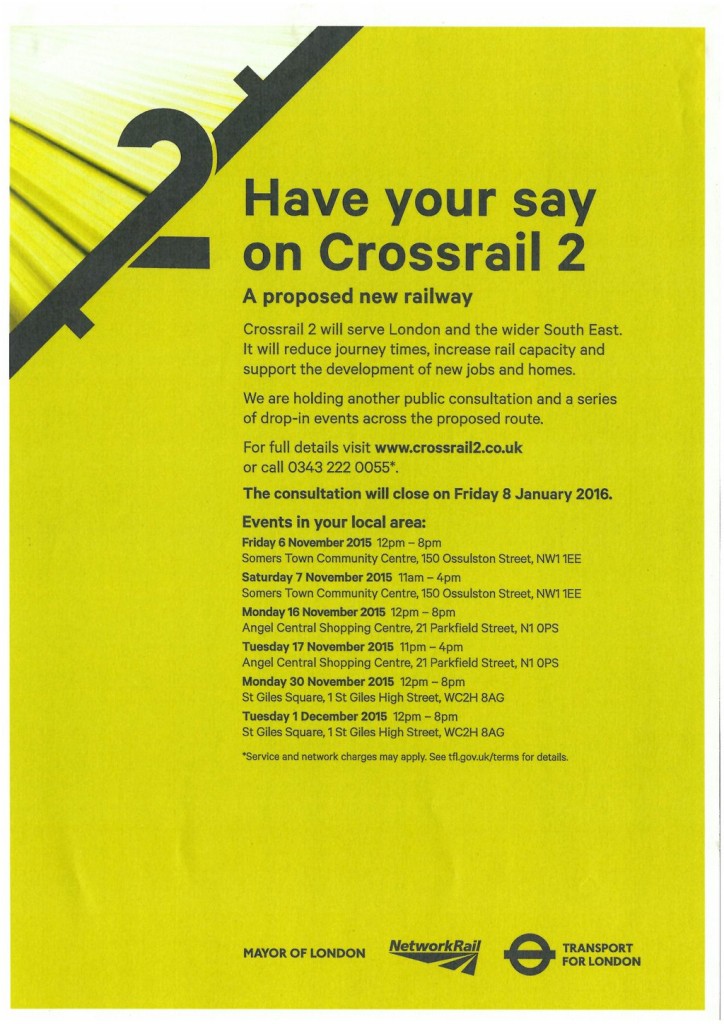
Here is an open invitation to visit the Crossrail 2 exhibition and have your say. We’ll be there too and will share our thoughts via Twitter. The closest place is St Giles Circus, 30th November and 1st December. See you there!

by Julia Haythorn | Nov 3, 2015 | Info
Gerald Eve have just published their quarter three review of West End Office Space. WestEndFloorReview_Q3_2015.pdf
f
This review offers another definition of the West End (that runs right across Bloomsbury and Covent Garden)
The figures for Fitzrovia and Bloomsbury indicate a massive take-up of office space. The rental values are shooting up as well.

The report states that
‘As well as Facebook committing to almost 230,000 sq ft at One Rathbone Place in Fitzrovia, several game and software developers signed up to West End space during Q3. Proportionately, this was most pronounced in Soho, as the TMT sector accounted for 82% of all space taken.’
Having a quick discussion on Twitter this afternoon with Steve Chambers @respros over in Soho, we both conclude that the rise in residential schemes has started to edge office space out of the picture. GE report that demand for small spaces is dwindling – but might that be because the rentals are too high right now for any entry level business to consider.

by Julia Haythorn | Nov 2, 2015 | Environment, Our Neighbourhood, Public Space, The Plan
This week I have been thinking about the environmental benefit of roof gardens and edible gardens in particular. My thoughts have been driven by two very different events. The first is that the West End Partnership have been adding flesh to the bones of their plans for London’s West End. As a member of their Peoples Task Group, I needed to consider, among other topics, what their emerging greening strategies might mean for people who work here, live here or visit Fitzrovia.
And in another, completely unconnected event, my own rooftop garden features in this month’s Garden Magazine, the organ of the Royal Horticultural Society(RHS). It is a special issue devoted to urban gardens.

My own rooftopvegplot. Open by appointment April – September
If you are not a member of the RHS then this might be a good time to join. The organisation is slowly becoming a little more progressive and organic gardening, protection of wildlife and greening the urban realm are now all on their agenda. People like me, who do not own acres of manicured evergreens somewhere in the Dukeries, are now welcomed. I’m rather proud that a productive, urban, organic garden, the size of a postage stamp is featured within the hallowed pages.
The RHS is taking a number of excellent initiatives that the most progressive of urban gardeners and the most devoted of environmentalists would approve. In this issue November 2015, the magazine is suggesting how we can find space and place to plant more. Their ‘Greening Grey Britain’ initiative.
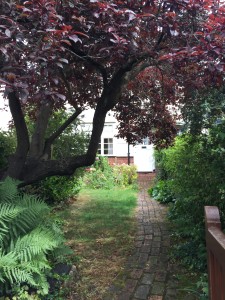
Front gardens make an amazing difference. But we don’t have front gardens in the inner city!
The RHS are right on the button when they say that gardens play a crucial role in urban and suburban areas, and potentially will become even more important in the future as our climate changes. From helping protect us against flooding and extremes of temperature, to supporting wildlife and helping gardeners to be healthy, gardens can provide an amazing range of benefits.
https://www.rhs.org.uk/science/gardening-in-a-changing-world/Greening-Grey-Britain/urban-planting
The estimate is that 25% of the urban realm is open space, that might be transformed into a garden. That could be a formal flower garden, a wild space, a flowering place for pollinators or an allotment. Gardens can be at ground level, on balconies or on rooftops. Temporary gardens can be found on building sites. So called guerrilla gardens can spring up anywhere. We have our own guerrilla gardens in Great Titchfield Street, started by one of the flat dwellers in Collingwood House. The idea has proved infectious, the space around trees in the street have been invaded by flowers right up as far as the restaurant Conchiglia and the Smile Clinic. Well done to those businesses for taking up the initiative. It’s a great pleasure to walk down that part of the street now. (Though I despair at the number of cigarette butts I see casually tossed into flower beds.)

Guerrilla Gardening in Great Titchfield Street
My own contribution to greening the city is a rooftop vegetable plot, designed to be intensively productive all year round as well as beautiful. It is organic, and full of flowering produce as well as leaves and roots. I have bee hotels up there, a stick tower for insects and several bird feeders and nesting boxes. You can find the article in this month’s RHS magazine, or in the recently published book, ‘My Tiny Veg Plot’ by Lia Leendertz. Pavillion, Books 2015. This lavishly illustrated book is an excellent resource for different urban/small space gardening techniques.
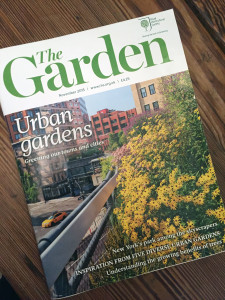
As part of the FitzWest Neighbourhood Plan we will be looking at how we can improve the urban space. That’s about reducing deliveries, traffic calming and improving space for pedestrians and cycles. It’s about improving our rubbish collection system so that the streets are no longer strewn with take-away cartons and banana skins. It’s about management of contractors and street diggers, so that builders rubble, skips and cranes don’t litter the streets, causing danger to pedestrians and blocking carriageways. And it’s also about finding more places for planting.
A survey of green space in FitzEast has already been completed for the Business Improvement District. This is an issue that touches those who work or visit the area as much as it does residents. We need something similar in FitzWest.
if you would like to join FitzWest please visit this page of the website:
https://fitzwest.org/become-a-member/
And if you’d like to help with the survey of public space and greening of FitzWest email me, Wendy Shillam on info@fitzwest.org
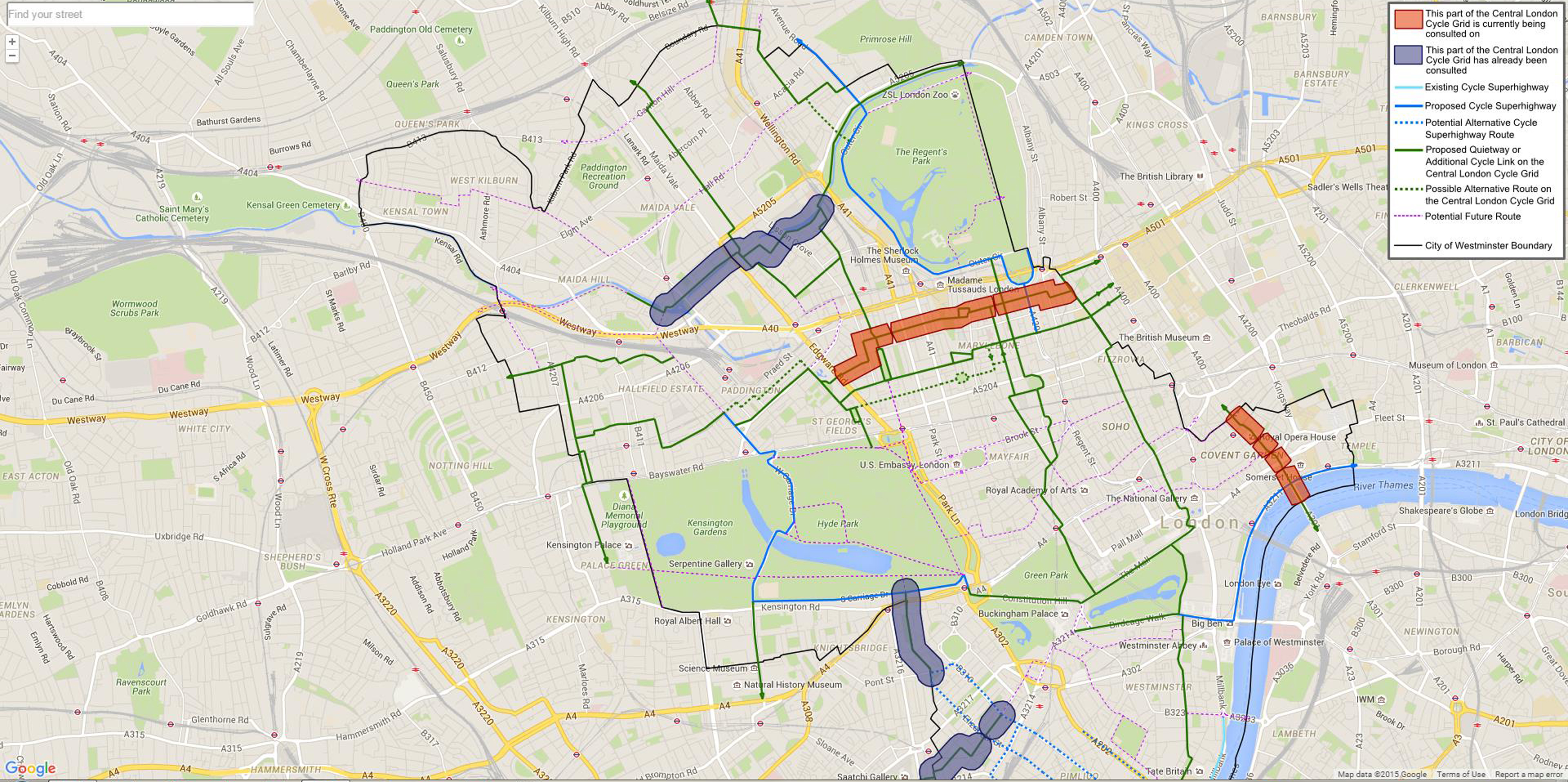
by Julia Haythorn | Oct 13, 2015 | Consultations, Public Space
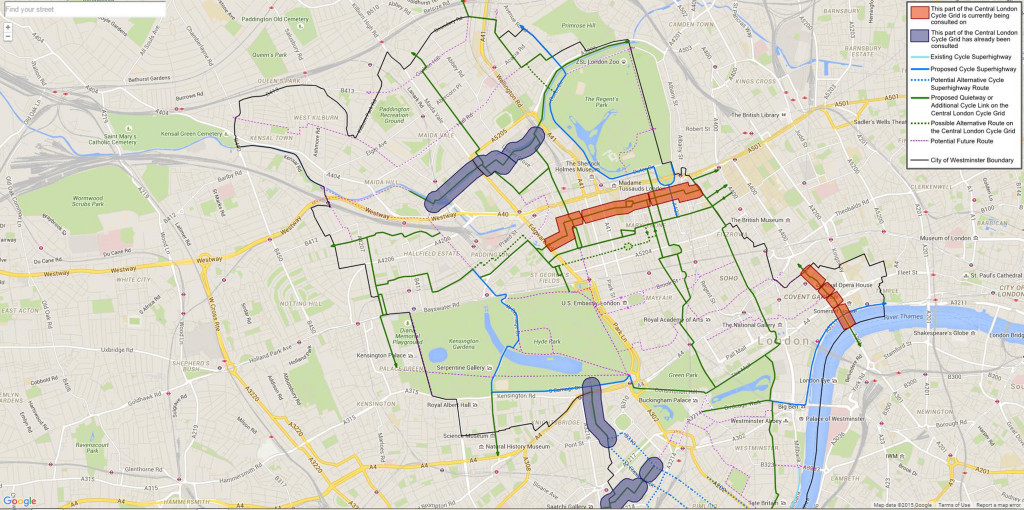
Westminster Consultation on Cycling QuietWay from Edgeware Road to Fitzrovia
The Greater London Authority has developed a cycling strategy, which involved super highways and quiet routes which criss-cross the city. In Westminster several of these proposed routes run through FitzWest. The Fitzrovia Neighbourhood Forum welcomes the attempt to link up the city and to devise routes where less experienced cyclists might feel more comfortable.
The proposals are modest. They include a cycle waiting area at the head of junction stop lines on major roads and a small cycle priority path leading up to the junction. The proposals do not designate an area of the carriageway for cycles, do not provide cycle only phases to traffic lights and do not attempt to calm or restrict traffic in any way. There is a modest section of cycle contra-flow adjacent to Holcroft Court.
We dont believe that cycle quiet routes can be achieved without closing roads to vehicular traffic or (at the very least) reducing access, type and speed of traffic on the proposed cycling quiet routes.
In principle we believe that cyclists and pedestrians should have priority over vehicles on all but the most major thoroughfares, throughout the West End. Many people live and work here. We agree with the GLA that the best method of transport for many of those people is walking and cycling. But we also see that a plateau of cycle road users will be reached unless cars and other vehicles are not also restricted in their use of side streets. This could be achieved with quiet zones, speed limits, traffic calming and cycle/pedestrian priority areas.
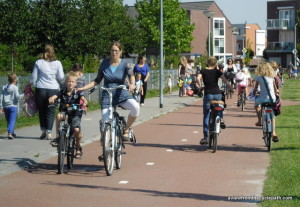
In Fitzrovia the narrowness of the streets, the quantity of on-street parking and the volume of deliveries, all mitigate against a successful cycling system. We believe that quiet routes should be introduced, but we don’t feel that the measures taken, which are minimal, will make a lot of difference. Vehicles, deliveries and parking must be better managed on these roads in order for them to be useful for novice cyclists.
In addition the measures taken to allow cycles to cross major road junctions seem flimsy. Putting a priority waiting space in front of traffic is a useful measure, but it is not enough. Cycle priority lights would be one solution, where cycles have their own green phase – perhaps linking with better pedestrian crossing facilities.
We enclose some images of quiet routes from Dutch and Danish cities to illustrate the difference between Westminster’s proposal and more enlightened cities.
We will be commenting formally to Westminster CC soon. Please leave your views here and we will take account of them in our response.
Thank you.
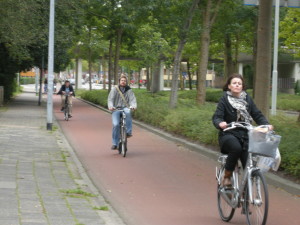
Read the full details















